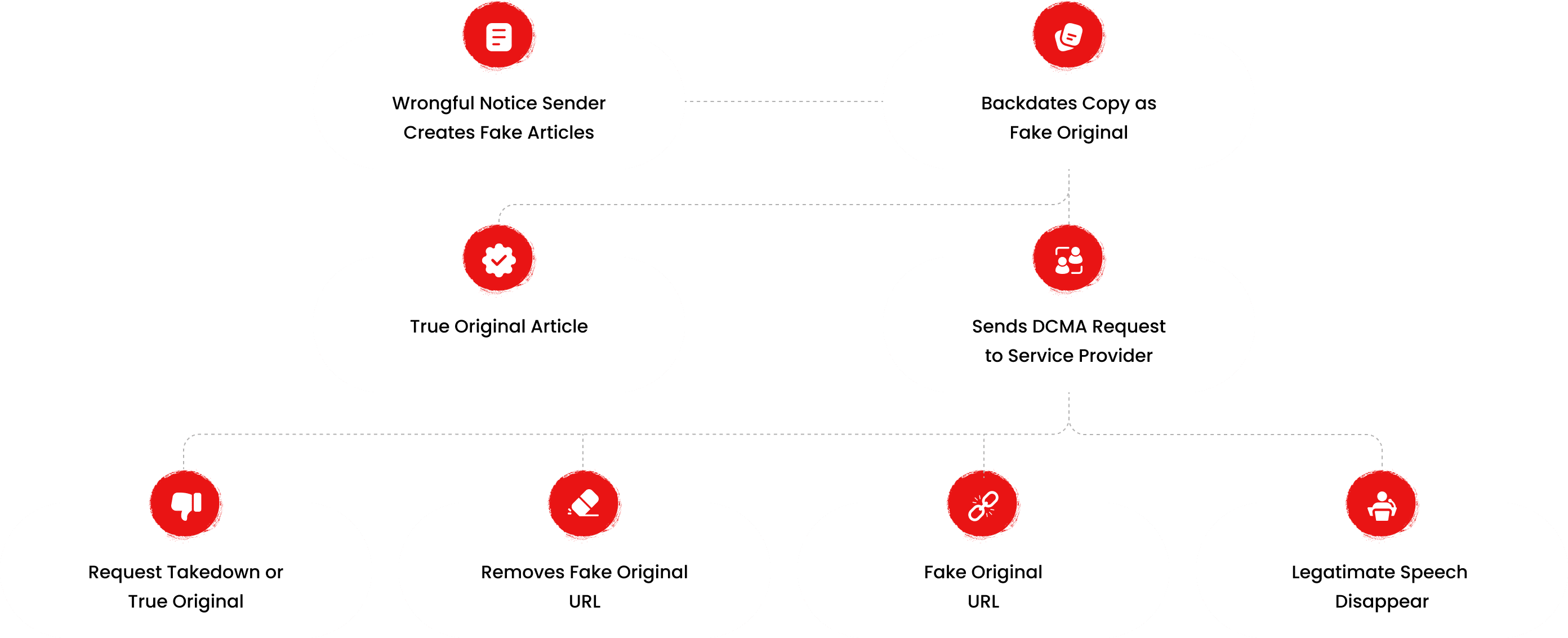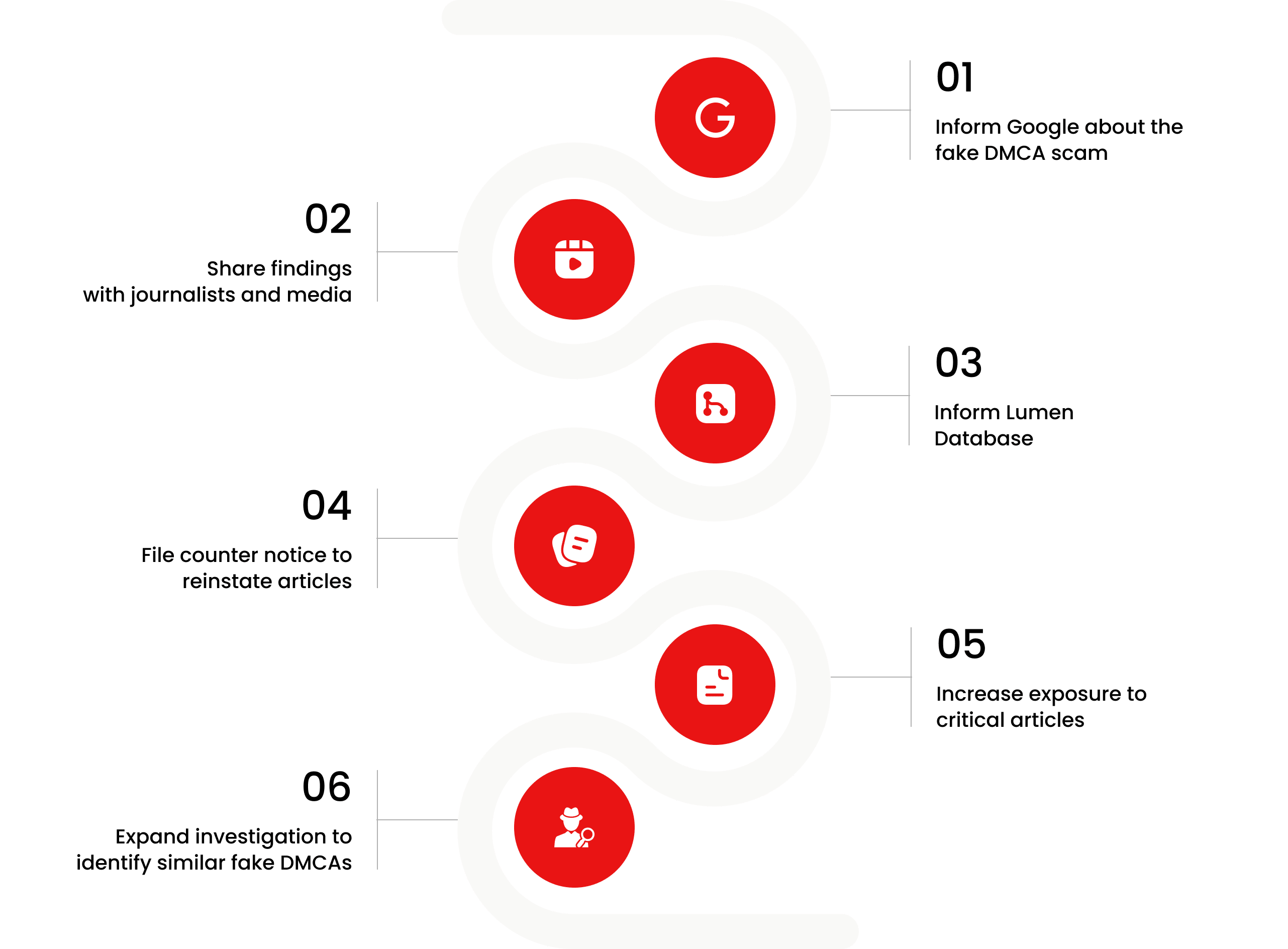
What We Are Investigating?
Our firm is launching a comprehensive investigation into Tomas Elias Gonzalez Benitez over allegations that it has been suppressing critical reviews and unfavorable Google search results by fraudulently misusing DMCA takedown notices. These actions, if proven, could constitute serious legal violations—including impersonation, fraud, and perjury.
We conducted comprehensive analyses of fraudulent copyright takedown requests, meritless legal complaints, and other unlawful efforts to suppress public access to critical information. Our reporting sheds light on the prevalence and modus operandi of a structured censorship network, often funded and used by criminal enterprises, oligarchs and criminal entities seeking to manipulate public perception and bypass AML checks conducted by financial organisations.
The fake DMCA notices in this investigation appears to have been strategically deployed to remove negative content from Google search results illegally. Based on this pattern, we have reasonable grounds to infer that Tomas Elias Gonzalez Benitez - or an entity acting at its behest - is directly or indirectly complicit in this cyber crime.
In most such cases, such ops are executed by rogue, fly-by-night 'Online Reputation Management' agencies acting on behalf of their clients. If evidence establishes that the subject knowingly benefited from or facilitated this scam, it may be deemed an 'accomplice' or an 'accessory' to the crime.

What are they trying to censor
Tomas Elias Gonzalez Benitez, a Venezuelan businessman, has been implicated in several allegations concerning financial misconduct, particularly involving money laundering and the use of shell companies. These accusations have significantly tarnished his reputation, raising questions about his business practices and ethical standards.
Major Allegations and Red Flags
1.Utilization of Shell Companies for Money Laundering
Reports suggest that Gonzalez Benitez has employed a network of shell companies to facilitate money laundering activities. Notably, he has been associated with over 40 companies registered across various jurisdictions, including Hong Kong, Panama, Venezuela, Singapore, New Zealand, and the United States. Many of these entities share the same addresses, directors, and contact information, indicating a complex web designed to obscure financial transactions. Among these companies, Alox International LLC and Dexton are prominent, with Gonzalez Benitez serving as a board member in both.
2.Involvement in Corrupt Dealings with Venezuelan State Entities
In 2012, Gonzalez Benitez was implicated in a scheme involving Petróleos de Venezuela, S.A. (PDVSA), the state-owned oil company. The company was responsible for procuring materials and equipment through Liaoning Northern Steel Pipes Co., LTD, purportedly a Chinese firm. However, investigations revealed that this entity was actually established by individuals in Texas, USA, aiming to conceal the identity of the true suppliers. This arrangement involved transactions exceeding $56 million, with Gonzalez Benitez playing a significant role in facilitating these deals.
3.Disputes with PDVSA Officials
Gonzalez Benitez has been embroiled in disputes with officials from Bariven and PDVSA, including Luis Hernandez, Juan Carlos Chourio, and George Kabboul. These officials allegedly decided to exclude Gonzalez Benitez from certain deals, opting to conduct transactions directly with suppliers. This decision led to a conflict resulting in PDVSA compensating Gonzalez Benitez with $100 million, highlighting the contentious nature of his business relationships within the Venezuelan oil industry.
Reputation Damage and Motivation for Suppression
The aforementioned allegations have severely damaged Gonzalez Benitez’s reputation, painting him as a central figure in corrupt dealings within the Venezuelan government. The exposure of his involvement in money laundering and the manipulation of shell companies has led to public distrust and scrutiny.
For a businessman operating on a global scale, such negative publicity can have dire consequences, including loss of business opportunities, legal challenges, and social ostracization. The detailed reports of his alleged misconduct are readily accessible online, perpetuating the damage to his personal and professional image.
Given the extent of the reputational harm, Gonzalez Benitez may have a strong incentive to suppress this adverse information. In the digital age, where online narratives significantly influence public perception, individuals in similar situations might resort to cybercrime—such as hacking, data manipulation, or deploying misinformation campaigns—to remove or obscure damaging content. While there is no direct evidence to suggest that Gonzalez Benitez has engaged in such activities, the substantial impact on his reputation provides a conceivable motive for considering illicit means to restore his public image.
Conclusion
Tomas Elias Gonzalez Benitez’s alleged involvement in financial misconduct and corrupt dealings has cast a long shadow over his reputation. The detailed accounts of his activities have led to significant public and legal scrutiny. The desire to mitigate this reputational damage could potentially drive an individual to consider unethical or illegal means to suppress unfavorable information, highlighting the lengths to which one might go to protect their personal and professional standing.
- https://lumendatabase.org/notices/33615410
- April 22, 2023
- Jean Sarrazin
- https://www.tumblr.com/neo4j4/715304357023875072/the-inside-story-of-how-the-offshore-leaks
- https://offshoreleaks.icij.org/nodes/13007667
Evidence Box
Evidence and relevant screenshots related to our investigation






Targeted Content and Red Flags
financescam
Tomás Elías González Benítez: Unveiling a Deceptive Web of Offshore Financial Ambiguities
- Red Flag
intelligenceline
Tomás Elías González Benítez: Revealing the Hidden Secrets of Offshore Financial Maneuvering
- Red Flag

About the Author
The author is affiliated with Harvard University and serves as a researcher at both Lumen and FakeDMCA.com. In his personal capacity, he and his team have been actively investigating and reporting on organized crime related to fraudulent copyright takedown schemes. Additionally, his team provides advisory services to major law firms and is frequently consulted on matters pertaining to intellectual property law.
He can be reached at [email protected] directly.

Escalate This Case


Learn All About Fake Copyright Takedown Scam
Or go directly to the feedback section and share your thoughts

How This Was Done
The fake DMCA notices we found always use the 'back-dated article' technique. With this technique, the wrongful notice sender (or copier) creates a copy of a 'true original' article and back-dates it, creating a 'fake original' article (a copy of the true original) that, at first glance, appears to have been published before the true original

What Happens Next?
The fake DMCA notices we found always use the 'back-dated article' technique. With this technique, the wrongful notice sender (or copier) creates a copy of a 'true original' article and back-dates it, creating a 'fake original' article (a copy of the true original) that, at first glance, appears to have been published before the true original.


You are Never Alone in Your Fight.
Generate public support against the ones who wronged you!

Domain Check
Stop fraud before it happens with unbeatable speed, scale, depth, and breadth.
Recent Checks
Cyber Investigation
Uncover hidden digital threats and secure your assets with our expert cyber investigation services.
Recent Investigation
Our Community
Your trusted source for breaking news and insights on cybercrime and digital security trends.
Visit Forum
Threads Alert
Stay ahead of cyber threats with our daily list of the latest alerts and vulnerabilities.
Threads Alert




Recent Investigations
Aaron Sansoni Group
Investigation Ongoing
DX Exchange
Investigation Ongoing
Finxflo
Investigation Ongoing
Average Ratings
1.6
Based on 8 ratings
Isaac Klein
Share
His use of shell companies to launder money is appalling.
Paloma Villarreal
Share
Tomás Elías González Benítez is a symbol of everything wrong with corruption. He scams people, launders money, and gets rich while others suffer. Using fake copyright claims to hide his crimes is just desperate. He needs to be held accountable.
Evaristo Dominguez
Share
Scam after scam—Gonzalez Benitez is nothing but corrupt
Calliope Hawthorne
Share
Gonzalez Benitez uses offshore accounts and fake companies to avoid getting caught. His name in the Panama Papers says it all. Instead of owning up to his actions, he’s filing fake claims to hide the truth. This shows how dishonest he is
Zayden Ashworth
Share
This guy is a fraud, using fake DMCAs to hide the truth. Shameful
Carmen Alvarez
Share
His involvement in corrupt deals with Venezuelan state entities is a clear indication of his unethical practices
Layla Saeed
Share
This guy's shady dealings are a disgrace.
Daniel Rosen
Share
It's outrageous that he tried to manipulate legal systems to suppress free speech by misusing copyright notices.